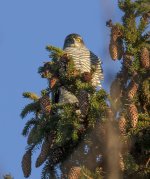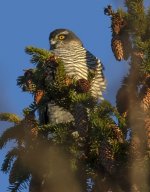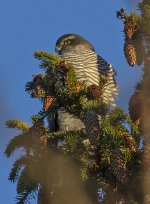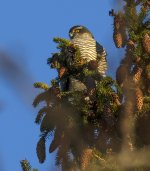Macswede
Macswede
Recently, in the immediate vicinity, we've had a male Goshawk flying overhead, a male Sparrowhawk that took a Great Tit behind the feeders and a female Goshawk amidst a flock of Fieldfares. All these birds were easily identified but this one, seen earlier today, was a long way off at the top of a tree and partially hidden by branches.
I thought it was a female Sparrowhawk based on the yellow eyes and the comparatively light build but my wife reckoned it was a male Goshawk as she felt it was too bulky for a Sparrowhawk. Who is correct?
We probably have more Goshawks than Sparrowhawks in the area but neither species is uncommon.
I thought it was a female Sparrowhawk based on the yellow eyes and the comparatively light build but my wife reckoned it was a male Goshawk as she felt it was too bulky for a Sparrowhawk. Who is correct?
We probably have more Goshawks than Sparrowhawks in the area but neither species is uncommon.







